All along, industrial sources have been the main source channels of air pollutants. In order to deepen the battle for blue skies, the Ministry of Ecology and Environment and other 15 departments recently issued the "in-depth fight to eliminate heavy polluted weather, ozone pollution prevention and control and diesel truck pollution treatment offensive action plan", around the three landmark battles, and then mention from the source to reduce air pollutants and carbon emissions, resolutely curb the "two high" project blind development, industrial Green transformation and upgrading requirements.
In early November 2022, the website of the Ministry of Ecology and Environment officially released four national air pollutant emission standards, "Emission Standards for Air Pollutants in Printing Industry", "Emission Standards for Air Pollutants in Glass Industry", "Emission Standards for Air Pollutants in Mineral Wool Industry", "Emission Standards for Air Pollutants in Lime and Calcium Carbide Industry", which will be officially implemented from January 1, 2023. January 1, 2023, the official implementation.
Emission Standards for Air Pollutants in the Printing Industry (GB 41616-2022)
Standard for the first time, based on the whole process of control and management ideas from source reduction, process control to end of treatment, organized emissions and unorganized emissions control two-pronged approach to further regulate the emissions of printing enterprises.
The standard specifies the printing industry air pollutant emission control requirements, monitoring and supervision and management requirements; applies to the management of air pollutant emissions from existing printing industry enterprises or production facilities, as well as environmental impact assessment of printing industry construction projects, environmental protection facilities design, completion of environmental protection acceptance, emission permit issuance and air pollutant emission management after its commissioning.
New enterprises since January 1 next year, existing enterprises since July 1, 2024, their air pollutant emission control in accordance with the provisions of this standard, no longer implement the relevant provisions of the "Comprehensive Emission Standards for Air Pollutants (GB 16297-1996)".
Emission Standards for Air Pollutants in Glass Industry (GB 26453-2022)
The standard is the first revision of the 2011 version, expanding the scope of application of the standard, including glass manufacturing, glass products manufacturing, glass fiber and products manufacturing, and further tighten the emission limits of air pollutants, while increasing the requirements for the control of disorganized emissions. The standard is based on the principles of precise and scientific pollution control, pollution reduction and carbon reduction and synergy, the implementation of air pollutants and greenhouse gas synergistic emission reduction and synergistic management, and strengthen the whole process of collaborative emission control based on source emission reduction and process control.
The standard applies to the management of air pollutant emissions from existing glass industry enterprises or production facilities, as well as the environmental impact assessment, design of environmental protection facilities, acceptance of completed environmental protection, issuance of emission permits and management of air pollutant emissions from glass industry construction projects after their commissioning. The implementation time for new and existing enterprises is the same as above.
Emission Standards for Air Pollutants in the Mineral Wool Industry (GB 41617-2022)
Standard for the first time, applicable to the management of air pollutant emissions from existing mineral wool industrial enterprises or production facilities, as well as the environmental impact assessment of mineral wool industrial construction projects, environmental protection facilities design, completion of environmental protection acceptance, emission permit issuance and the management of air pollutant emissions after its commissioning.
China is a large producer of mineral wool, rock (mineral) cotton production accounted for about 55% of world production, glass wool production accounted for 40% of world production, but the current standard industry-specific is not strong, part of the lax emission limits. Therefore, the new standard is based on the principle of precise and scientific pollution control, pollution reduction and carbon synergy, the implementation of air pollutants and greenhouse gas synergistic emission reduction and synergistic management, to strengthen the source reduction, process control to the end of the whole process of control and management.
The execution time is the same as above.
Emission Standards for Air Pollutants in the Lime and Calcium Carbide Industry (GB 41618-2022)
The standard is released for the first time, in accordance with the principle of problem-oriented and precise policy, and adheres to the concept of systematic management of source reduction, process control to end-of-pipe treatment, which is highly industry-specific. Previously, the industry implementation of the "Industrial Furnace Air Pollutant Emission Standards" and "Comprehensive Emission Standards for Air Pollutants" is poorly targeted, so the implementation process has many problems.
The new standard specifies the lime, calcium carbide industry air pollutant emission control requirements, monitoring and supervision requirements; applicable to existing lime, calcium carbide industry enterprises or production facilities for the management of air pollutant emissions, as well as lime, calcium carbide industry construction projects environmental impact assessment, environmental protection facilities design, completion of environmental protection acceptance, emission permit issuance and the management of air pollutant emissions after its commissioning. At the same time, the iron and steel industry, aluminum industry and other industry enterprises in the lime production process air pollutant emissions also need to implement the relevant provisions.
The execution time is the same as above.
With the implementation of the four standards, China's printing, glass, mineral wool, lime / calcium carbide four major industrial areas of industrial waste gas emission reduction more evidence-based, will strengthen the relevant enterprises focus on waste gas treatment, drive the industry's production methods green upgrade, to achieve high-quality development, as well as economic and environmental benefits of a win-win situation.
Source: Environmental Protection Online

